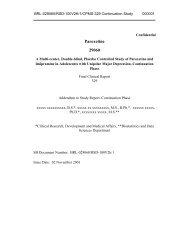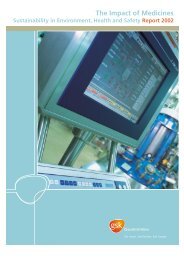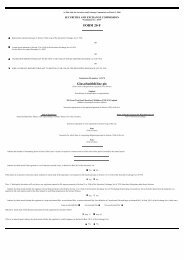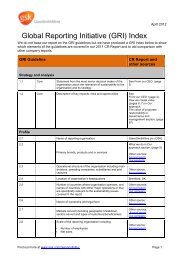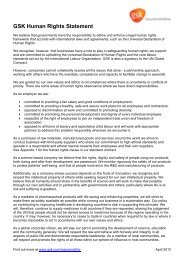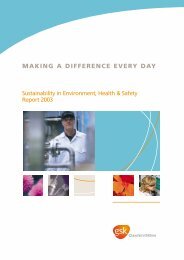GSK Annual Report 2002
GSK Annual Report 2002
GSK Annual Report 2002
Create successful ePaper yourself
Turn your PDF publications into a flip-book with our unique Google optimized e-Paper software.
72 GlaxoSmithKline Operating and financial review and prospects<br />
Results under US accounting principles <strong>2002</strong> and 2001<br />
This review discusses the results of GlaxoSmithKline plc for the<br />
years <strong>2002</strong> and 2001 and shareholders’ equity at 31st December<br />
<strong>2002</strong> prepared under US accounting principles. See Note 37 to the<br />
Financial statements, ‘Reconciliation to US accounting principles’.<br />
Results <strong>2002</strong> and 2001<br />
<strong>2002</strong> 2001<br />
Summary of results £m £m<br />
Sales 21,212 20,489<br />
Trading profit 5,243 4,205<br />
Operating profit 1,026 590<br />
Profit before tax 925 494<br />
Net income/(loss) before changes<br />
in accounting principles 503 (143)<br />
Cumulative effect of changes<br />
in accounting principles (90) –<br />
Net income/(loss) 413 (143)<br />
Basic net income/(loss) per share (pence) 7.0 (2.4)<br />
Operating profit is lower on a US GAAP basis than a UK GAAP<br />
basis, primarily as a result of the amortisation and impairment of<br />
intangible assets not recorded on the balance sheet under UK<br />
GAAP. Operating profit also includes a charge under SFAS 123 for<br />
stock-based compensation and a charge for pension and postretirement<br />
benefits. These are partially offset in net income by the<br />
related deferred tax credits.<br />
The Group adopted SFAS 142 as of 1st January <strong>2002</strong>. The<br />
implementation of SFAS 142 resulted in an initial impairment of<br />
£127 million, net of tax, on indefinite lived intangible assets. During<br />
<strong>2002</strong>, the Group also aligned the measurement date for all its<br />
pension plans to 31st December. The impact was a £37 million<br />
credit, net of tax. Both changes are reflected as cumulative effects<br />
of changes in accounting principles.<br />
The effect of these differences from UK GAAP leads in <strong>2002</strong> to a<br />
US GAAP profit before tax of £925 million and, after tax and<br />
minority interest and the cumulative effect of changes in<br />
accounting principles, net income for the year of £413 million.<br />
In 2001 profit before tax was £494 million and, after tax and<br />
minority interest, the net loss was £143 million.<br />
Shareholders’ equity at 31st December <strong>2002</strong><br />
<strong>2002</strong> 2001<br />
Changes in shareholders’ equity £m £m<br />
At beginning of year 40,107 44,995<br />
Net income/(loss) 413 (143)<br />
Shares purchased and cancelled (2,220) (1,274)<br />
Share issues (share options) 56 144<br />
Treasury stock 58 (501)<br />
Dividends (2,310) (2,872)<br />
Minimum pension liability (1,446) –<br />
Other 264 (242)<br />
At end of year 34,922 40,107<br />
The book values of GlaxoSmithKline net assets on a UK GAAP basis<br />
are adjusted for the normal UK/US GAAP differences. The principal<br />
adjustments to net assets for differences between UK and US GAAP<br />
include: goodwill and intangible assets from Glaxo’s acquisition of<br />
Wellcome and Glaxo Wellcome’s acquisition of SmithKline Beecham;<br />
dividends on a declared rather than proposed basis; treatment of<br />
shares held by the ESOTs as treasury stock rather than investments;<br />
and inclusion of a minimum pension liability in net assets.<br />
Prospects<br />
GlaxoSmithKline has published expectations of future growth in<br />
earnings per share, on a UK GAAP basis, and excluding merger<br />
and restructuring items. See ‘Outlook’ on page 64.<br />
Recent Financial Accounting Standards Board (FASB)<br />
pronouncements<br />
In June 2001, the FASB approved SFAS 143 ‘Accounting for<br />
Obligations Associated with the Retirement of Long-Lived Assets’<br />
which requires that the fair values of the obligation associated<br />
with the retirement of long-lived assets be capitalised as part of<br />
the cost. This was implemented by the Group with effect from<br />
1st January 2003. The Group does not believe the adoption of<br />
this standard will have a material impact on its results.<br />
On 1st January <strong>2002</strong>, SFAS 144 ‘Accounting for the Impairment<br />
or Disposal of Long-Lived Assets’ was adopted by the Group.<br />
SFAS 144 develops one accounting model for long-lived assets,<br />
including discontinued operations to be disposed of by sale. It<br />
requires that all long-lived assets be measured at the lower of<br />
carrying amount or fair value less cost to sell whether reported in<br />
continuing or discontinued operations. The adoption of SFAS 144<br />
has not had a material impact on the Group’s Financial<br />
statements.<br />
In April <strong>2002</strong>, SFAS 145 ‘Rescission of FASB Statements no. 4,<br />
44 and 64, Amendment of FASB Statement no. 13 and Technical<br />
Corrections’ was issued. The statement updates, clarifies and<br />
simplifies existing accounting standards. The Group does not<br />
believe the adoption of this standard will have a material impact<br />
on its results.<br />
SFAS 146 ‘Accounting for Costs Associated with Exit or Disposal<br />
Activities’, was issued in June <strong>2002</strong>. SFAS 146 requires companies<br />
to recognise costs associated with exit or disposal activities when<br />
they are incurred rather than at the date of a commitment to an<br />
exit or disposal plan and is to be applied prospectively to exit or<br />
disposal activities initiated after 31st December <strong>2002</strong>. The Group<br />
is currently assessing the impact of this standard.<br />
In November <strong>2002</strong>, the FASB published Interpretation no. 45,<br />
‘Guarantor’s Accounting and Disclosures requirements for<br />
Guarantees, Including Indirect Guarantees of Indebtedness of<br />
Others’ (FIN 45). FIN 45 expands on the accounting guidance of<br />
other SFASs. FIN 45’s provisions for initial recognition and<br />
measurement should be applied to guarantees issued or modified<br />
after 31st December <strong>2002</strong>. The disclosure requirements are<br />
effective for financial years ending after 15th December <strong>2002</strong>.<br />
The Group does not believe that the adoption of FIN 45 will<br />
have a material impact on its results.<br />
In January 2003, the FASB published Interpretation no. 46,<br />
‘Consideration of Variable Interest Entities’ (FIN 46). Under FIN 46<br />
the primary beneficiary of the entity must consolidate certain<br />
entities known as Variable Interest Entities. The measurement<br />
principles will apply to the Group’s 2003 Financial statements.<br />
The Group does not believe that the adoption of FIN 46 will<br />
have a material impact on its results.








